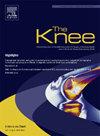胫骨接触点不能用于确定原生胫股关节的内外轴向旋转。
IF 1.6
4区 医学
Q3 ORTHOPEDICS
引用次数: 0
摘要
背景:在研究原生膝关节的胫股关节运动学时,内-外(IE)轴向旋转是一个值得关注的运动。股骨与胫骨的接触位置(称为胫骨接触点)已被用于确定内-外旋转,但由于误差较大,这种旋转可能并无用处。因此,我们的目标是确定胫骨接触点是否有助于量化原生膝关节的 IE 旋转:方法:我们分析了 25 名进行负重膝关节深屈的受试者的原生膝关节透视图像。为每个受试者创建了三维骨骼+软骨模型。在三维模型与二维图像配准后,计算出每个股骨髁在屈曲 0°、30°、60° 和 90°时的最低点和胫骨接触点的前后(AP)位置。IE旋转是指在不同屈曲角度下,胫骨内侧和外侧各点连线之间的夹角:根据最低点,胫骨在股骨上的内旋转主要发生在屈曲的前 30°。在这一范围内,根据胫骨接触点计算的平均胫骨内旋可以忽略不计,但根据最低点计算的胫骨内旋明显更大(0° vs 7°,p = 0.0002)。在屈曲 90° 时,差异保持不变(1.8° vs 8.3°,p = 0.0007):结论:虽然胫骨接触点有助于研究全膝关节置换术(TKA)中胫骨假体的磨损情况,但胫骨接触点大大低估了原生膝关节屈曲时的胫骨内旋,因此不应被用于量化胫骨-股骨运动学。本文章由计算机程序翻译,如有差异,请以英文原文为准。
Tibial contact points cannot be used to determine internal-external axial rotation of the native tibiofemoral joint
Background
In the study of tibiofemoral kinematics of the native knee, internal-external (IE) axial rotation is a motion of interest. Locations of contact by the femur on the tibia (termed tibial contact points) have been used to determine IE rotations but such rotations might not be useful due to large error. Hence, our objective was to determine whether tibial contact points are useful in quantifying IE rotations of the native knee.
Method
Fluoroscopic images of the native knee were analyzed from 25 subjects who performed a weight-bearing deep knee bend. For each subject, 3D bone + cartilage models were created. Following 3D model-to-2D image registration, anterior-posterior (AP) positions of the lowest points and the tibial contact points were computed for each femoral condyle at 0°, 30°, 60°, and 90° of flexion. IE rotations were the angles between lines connecting points in the medial and lateral tibial compartments at different flexion angles.
Results
Based on the lowest points, the tibia rotated internally on the femur primarily during the first 30° of flexion. In this range, mean internal tibial rotation based on tibial contact points was negligible but internal tibial rotation was significantly greater based on lowest points (0° vs 7°, p = 0.0002). At 90° of flexion, the difference was maintained (1.8° vs 8.3°, p = 0.0007).
Conclusion
While tibial contact points are useful in the study of wear of tibial inserts in total knee arthroplasty (TKA), tibial contact points considerably underestimate internal tibial rotation during flexion in the native knee and should not be used to quantify tibiofemoral kinematics.
求助全文
通过发布文献求助,成功后即可免费获取论文全文。
去求助
来源期刊

Knee
医学-外科
CiteScore
3.80
自引率
5.30%
发文量
171
审稿时长
6 months
期刊介绍:
The Knee is an international journal publishing studies on the clinical treatment and fundamental biomechanical characteristics of this joint. The aim of the journal is to provide a vehicle relevant to surgeons, biomedical engineers, imaging specialists, materials scientists, rehabilitation personnel and all those with an interest in the knee.
The topics covered include, but are not limited to:
• Anatomy, physiology, morphology and biochemistry;
• Biomechanical studies;
• Advances in the development of prosthetic, orthotic and augmentation devices;
• Imaging and diagnostic techniques;
• Pathology;
• Trauma;
• Surgery;
• Rehabilitation.
 求助内容:
求助内容: 应助结果提醒方式:
应助结果提醒方式:


